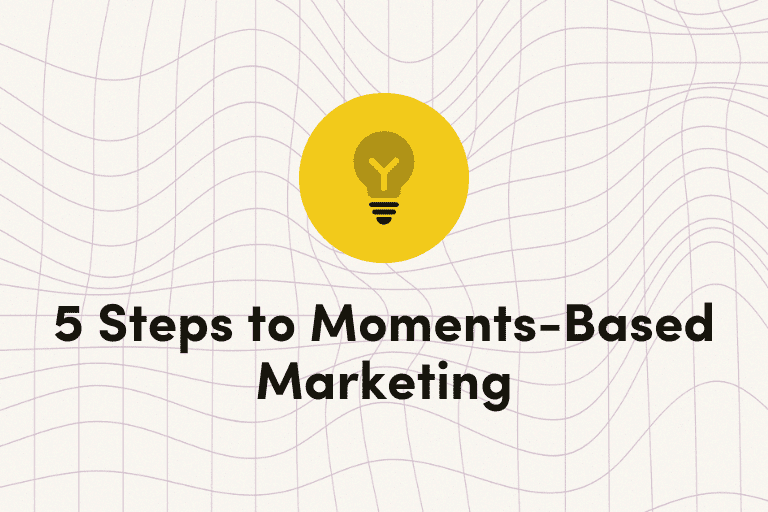Stewart Brand once said, “The fast-moving trends get most of the attention. The slow-moving trends have most of the power.”
Every new year brings about new industry predictions, but we thought that we’d take a different approach in 2019. Instead of rounding up experts and influencers to consult their crystal balls, we wanted to look back and examine the accuracy of our 2018 marketing predictions.
The verdict? Iterable’s predictions for 2018 were on the right track, but they haven’t come to fruition just yet. And they won’t be fully realized in 2019 either. But they do describe the direction that marketing organizations are striving toward—slowly but surely.
Read on to revisit our 2018 marketing predictions and judge for yourself!
1. Omni-channel marketing moves up the maturity curve
Going omni-channel has evolved from a wishful recommendation to a strategic requirement. After all, today’s consumers don’t see boundaries between the many devices they use and ways in which they interact with brands. That makes it essential for marketers to merge those many channels into one cohesive, seamless experience.
The expectation is so high, in fact, that McKinsey research shows a full 25 percent of customers will defect to competitors after just one bad experience. Marketing organizations can no longer approach campaigns and look at metrics on a platform-by-platform basis. We anticipate this year that if brands aren’t executing a successful omni-channel strategy—by getting their messaging right with each customer consistently across email, direct mail, mobile, web and social—then they should expect dire consequences when it comes to engagement.
It’s true that consumers aren’t aware of channels, but this was an ambitious declaration!
Only an exceptional few marketing organizations have made strides toward a fully omni-channel strategy. True omni-channel will always be an aspirational moving target—a utopian ideal that will forever be just a hint beyond reach.
In fact, this is one of the reasons why we prefer to discuss “cross-channel” engagement these days. The bigger and more established a company is, the more disparate data there’s sure to be. This data can be tough to normalize, centralize, and make actionable—which is often necessary before meaningful strides toward a cross-channel marketing strategy can be made.
However, these strides ARE happening, here and there, as more and more CMOs are turning to Customer Lifetime Value (LTV or CLV) as the ultimate measure of success. Short term conversions and individual channel performance are still prioritized, though, because they’re much easier to quantify.
Attribution remains a colossal obstacle, along with the tremendous cultural shifts that are necessary to break down internal silos and make teams more cross-functional, or at the very least, cross-thoughtful and -respectful.
So it’s happening—omni-channel is coming. But progress will be incredibly slow, and slowest still for the largest brands, in spite of hefty budgets. This creates a window of opportunity for smaller, more nimble operations, possibly for up to a decade.
2. Personalization makes way for individualization
For brands that go all-in on 1:1 personalization, the rewards can lead to brand-building moments in the national media and fiercely loyal customers: Think Spotify’s year-end playlists or Sephora’s hyper-targeted makeup tutorials. But in 2018, those outliers could become more and more the norm, as marketers that stick by the one-size-fits-all approach get left behind.
Personalization has already been proven to have real impact on a company’s bottom line. Research shows that it can reduce acquisition costs by as much as 50 percent, lift revenues up to 15 percent, and increase the efficiency of marketing spend by as much as 30 percent. In 2018, the conversation will move far beyond cohorts and segments, instead focusing on winning over each individual subscriber.
2014 was the year forward-thinking marketers set a new gold standard for 1:1 personalization with “year in review” (YIR) email campaigns. They were and continue to be a big hit—folks love to see playful, detailed summaries of their personal activity—even Iterable has jumped on the bandwagon.
💌 Nifty year-end email from @Iterable: https://t.co/tFAQRw9TWr #emailgeeks pic.twitter.com/dXjI64d53K
— Ted Goas (@TedGoas) December 19, 2018
Today, they’ve become a pretty standard element of a cross-channel program, nearly as ubiquitous as birthday campaigns.
The YIR was a spectacular and rare revelation. It seemed like a harbinger of an exciting wave of 1:1 messaging. But we haven’t seen much that’s quite as clever in the past four years, and in many organizations, it’s the only genuine example of 1:1 they’re producing.
Something that’s pretty universal to growth marketers is that they’re a smart lot. They want to deliver exceptionally personalized campaigns, and they always have a few ideas of what they would do if given the opportunity, but they’re often resource-strapped and struggling to level-up their marketing maturity. Email, in particular, is the most powerful personalization channel but continues to be allotted the most meager slices of marketing budgets.
As I mentioned before, real change comes from the top down, and LTV is a big driver of change right now. Email is gaining respect—slowly, of course—and I’m hopeful that means bigger bunches of Benjamins will be dedicated to this max-ROI channel in the years ahead so that greater movement toward 1:1 messaging as the rule, rather than the exception, can be achieved.
3. Content leads every conversation
When SmartInsights asked marketers to select the single marketing activity that would have the biggest commercial impact in 2018, content marketing was heads and shoulders above the likes of Big Data and the Internet of Things.
But content falls flat without context. Brands like Zillow do this beautifully with intelligent nurture campaigns across the customer lifecycle. They have a perfectly orchestrated series of workflows that customers trigger as they progress down the journey of buying or selling a home. Content remains king when it comes to facilitating 1:1 conversations and converting users into customers. The year ahead will see marketers doubling down on using highly relevant content to achieve true brand relevance.
Welp. Content and context SHOULD lead every conversation. It’s true. There’s no doubt that relevance drives engagement, and engagement has a delightful trickle-down effect to the bottom line.
And while more care is generally taken to ensure relevance in mobile channels, email is still a bit of a crapshoot.
For every Zillow, there are several dozen marketing organizations still leveraging a spray-and-pray, promotion-heavy approach to email while largely eschewing lifecycle campaigns and content strategies.
My observation is that many companies that are still reliant on batch ‘n blast are making some tweaks here and there. They’re rethinking their welcome campaigns and getting a bit more clever about reactivation. Some progress is underway. But the vast majority of campaigns remain scheduled with minimal segmentation and personalization. They’re still predominantly driven by calendars and short-term conversions, not by behaviors and long-term loyalty.
Why? First, it’s just what some brands are used to. That’s how it was always done. That was all that was expected. That was all that could be done with the MarTech of the time. Status quos are tough to topple.
But secondly—like it or not, it still works.
Is it ideal? Absolutely not. But subscribers are pretty tolerant of their favorite brands’ sending behavior because email isn’t terribly invasive. Promotional messaging is treated like inventory. It’s there behind the promotions tab when you need it and easily ignored when you don’t.
Marketing organizations that are highly reliant on scheduled promotions often say they want to move away from this strategy, but fear change will damage a reliable money-maker.
Those that never batched email are making great strides on this front, but evolution will continue to be tremendously slow-going for old-school retailers and etailers.
4. Dynamic content deepens each connection
Expanding on the previous prediction, content marketing gets its superpowers the more interactive it becomes. We’ll be seeing dynamic content spread across all channels in 2018. Video will continue its phenomenal rise, representing 82 percent of all web traffic by 2021, according to Cisco.
But dynamic content goes far beyond video. By using technologies like Movable Ink, brands are using gamification techniques to bring about real engagement. Incorporating interactive opportunities like live polling can bring 100-120% lifts in engagement, while scratch-offs can lift CTRs by 12 percent or more.
That group of marketers I mentioned above—the old school retailers and etailers—while they’re struggling to deliver meaningful content and lifecycle marketing, solutions like Movable Ink and Liveclicker make it easy for them to infuse their mainstay promotional campaigns with a little more engagement-driving oomph with minimal effort.
The novelty of certain out-of-the-box widgets—like scratch-offs and countdown clocks—will wear off as they become more ubiquitous, but vendors in this space will continue to innovate easy-to-implement interactive and open-time personalization elements.
Meanwhile, the real (though relatively rare) innovators continue to push the envelope with interactive email. That is, email that offers website functionality right inside the inbox, such as hover effects, drop-down menus, image carousels, forms, and live polls—even simple games and purchase transactions that take place entirely within the email client.
Outside of email, mobile marketers are increasingly doing a better job of leveraging dynamic fields to deliver personalization in the push channel, while SMS is getting utilized more widely for triggered, fully 1:1 transactional messaging.
5. Gen Z steps into the spotlight
It’s official: 2018 marks the end of the ‘90s kids—everyone who reaches adulthood this year was born in the year 2000. Thus, marketers immersed in a millennial mindset will soon find themselves missing a surging customer base. While millennials are currently retailers’ largest demographic, Gen Z—those born between roughly the mid-90s and mid-00s—is on the coming-of-age cusp, and actually outpaces the older cohort by some 3 million people.
To grab the ever-dwindling attention of today’s teens, you need to find ways to engage them by sending messages that truly resonate. Leading skincare brand Curology does this by interacting with their primarily teenage customers across email and SMS. This omni-channel approach has boosted engagement by 26 percent and pushed up profits by 10 percent.
There’s no arguing with any of this! Gen Z is entering adulthood. And it’s always been good advice to send the right message at the right time via the right channel.
Brands catering to the teen and young adult demographics are often among the leaders when it comes to cross-channel strategy because it’s simply an expectation of their audience.
Going forward, we’ll see more and more strategies that cater the channel to the individual subscriber or customer based on previous behavior and predictive technology.
6. AI evolves past theory into practice
This is the year that artificial intelligence, and its subsets of machine learning and deep learning, will be primed for production. According to Accenture, 80 percent of marketing executives believe that AI is poised to “revolutionize” the marketing industry by 2020.
A majority of B2C marketers are now using AI to understand customer behavior and personalize their experiences across channels, and they believe strongly that it will make their teams more effective and efficient. When it comes to delivering the right message on the right channel at the right time, 2018 will be the year that we merge human intuition with artificial intelligence.
It’s impossible to read through any list of predictions without mention of AI, and I understand why it was highlighted in Iterable’s 2018 list. It certainly is the future.
We need AI to overcome the obstacles that commonly prevent marketers from maximizing their digital messaging strategies. Our human brains and limited bandwidth cap what’s possible, and AI will take us much further.
I’ve read many articles proclaiming that AI has moved from nice-to-have to absolutely essential in recent months. But my observation is we’re moving a bit slowly on this front. A lot of AI is fairly rudimentary within the cross-channel space.
And a huge part of the problem is that loads and loads of actionable data are necessary to make AI work, but brands are struggling to centralize and normalize data to make it usable. It’s frequently in disparate silos. A “single source of truth” is more often an ambition than reality.
Data is the gas that powers AI engines. And data challenges are hampering advances on the AI front and adoption of existing technology.
I wish 2018 was the year human intuition merged with artificial intelligence. It is coming—but it’s evolving slowly.
7. Marketers activate on their agility and reclaim their creativity
Customers expect hyper-responsive, real-time interactions with brands, which means you must be able to iterate quickly, adapt on the fly and test strategies at scale. But this is impossible to do when your marketing team is bogged down with engineering-intensive platforms that require heavy coding.
Modern marketing solutions like Iterable put power back into the hands of marketers, so they can spend less time wrangling data and more time developing the creative, innovative campaigns that build brands. Mark your calendars, because on April 3, 2018, we’re celebrating this new age of agility with over 300 innovators at our debut Activate conference.
Heh heh. I see what you did there, 2018.
It’s true that more brands than ever are leveraging the power of Iterable to empower their savvy marketers. And Activate 18 was a terrific, insightful event!
Our prediction for 2019? Iterable’s Activate conference will deliver twice as much informative content to twice as many marketers. Hope you can join us for insights that are sure to supercharge your 2019 campaigns—register now to save your seat!
































